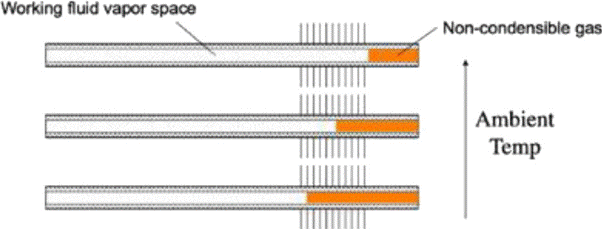|
Variable Conductance Heat
Pipes
Heat pipes – two-phase heat
transfer devices – in their basic form exhibit a
constant conductance (heat transfer capability)
that is demanded by the duty, for example
cooling a chip in a computer.
The main aim is to transfer as much heat
as possible from the chip to a heat sink where
it can be safely rejected to, for example,
cooling air.
Where there is a need to
control or modulate the heat transferred by the
heat pipe (or even to cut off heat transfer
completely), a Variable Conductance Heat Pipe
(VCHP) is employed.
The VCHP can operate in a
number of ways.
In the figure below a passive control
method relies on an inert gas buffer to block
part of the condenser section, this restricting
heat removal from the heat source (which would
be at the LHS of the pipes shown below).

As the ambient temperature
rises and more cooling is needed) the vapour in
the heat pipe compresses the gas, allowing more
area for heat rejection.
This has the interesting effect of
keeping the LHS of the heat pipe (or devices
mounted there) at a near-constant temperature.
The passive VCHP is capable
of limited temperature control. For more precise control an active
feedback-controlled VCHP can be used.
The research will identify
current VCHP technologies and build on this to
develop, starting from the basic VCHP,
a solid-state active feedback-controlled
VCHP for process/thermal control uses.
For more information please
contact Prof David Reay or
Prof Adam Harvey.
|